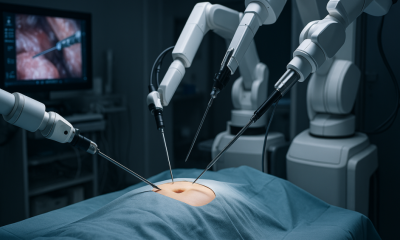Robotics
Insect-Inspired Robots Monitor Complex Environments

Researchers at the University of Pittsburgh have designed tiny insect-inspired robots that can be used in complex and tight environments hard to reach by humans.
The new research titled “Molecularly Directed, Geometrically-Latched, Impulsive Actuation Powers Sub-Gram Scale Motility” was published in the journal Advanced Materials Technologies.
Imaging and Environmental Evaluation
Junfeng Gao is a PhD student in industrial engineering at the Swanson School of Engineering. He led the work on the newly developed robots.
“These robots could be used to access confined areas for imaging or environmental evaluation, take water samples, or perform structural evaluations,” said Gao. “Anywhere you want to access confined places—where a bug could go but a person could not—these machines could be useful.”
This is yet another example of researchers looking to nature for inspiration to build today’s microbots. Tiny creatures like mantis shrimp and fleas can maneuver across surfaces in a way that is more energy-efficient than crawling by relying on impulsive movements. These movements were then replicated in the new robots made of polymeric artificial muscle.
Ravi Shankar is a professor of industrial engineering at Pitt. He controls the lab that led the new research.
“It’s akin to loading an arrow into a bow and shooting it—the robots latch on to build up energy and then release it in an impulsive burst to spring forward,” said Shankar. “Usually, actuation in the artificial muscles we work with is fairly slow. We were drawn to the question, ‘How do we take this artificial muscle and use it to generate a jumping actuation rather than slow actuation?’”
Turning to Molecular Order and Geometry
To answer this question, the team looked at molecular order and geometry.
Mohsen Tabrizi is a PhD student in industrial engineering at the Swanson School and co-author of the research.
“The curved composite shape of the polymer muscle allows it to build energy when it is powered. The way the molecules are aligned in the muscle draws inspiration from the natural world, where their combined actuation builds energy into the structure,” said Tabrizi. “This is accomplished using no more than a few volts of electricity.”
By designing the cricket-sized robots to be both versatile and lightweight, they can maneuver along moving surfaces like sand. They can carry out these movements just as easily as they do over hard surfaces. Most impressively, the robots can hop across water.
The research also included co-author Arul Clement.











